We have all heard the phrase ‘There is always two sides to the same story’. But, according to Jain wisdom, there are seven different ways of looking at the same situation.
When light enters a prism, it splits into a rainbow of seven distinct colours. Seven different aspects of the same light. From one perspective, you may see only indigo – but if you move to the other end of the spectrum, you will see red or green.
If we see the red light, our experience is true, but it doesn’t mean that is the whole story. Just because we see red light, doesn’t mean that others may not be seeing something else. Also, when we see red light, are we aware that its source is pure white light?
I was cycling through the countryside when I saw a church in the distance. Facing the setting sun, it was a grey shadow, blending into the milky sky – giving a rather ethereal shadow. Cycling to the foot of the church, I took this imposing picture of the church towering below.

That is just two images of the same church. But the real feeling of a church is gained by going in – not by just looking at external views.
Suppose we have a situation where two people are arguing and are in dispute. Who is right?
In this case, we can see two sides of the argument. One person feels that they are right. The other person, equally, feels they are right. Two sides to the same argument. But, there are also ways to look beyond this dispute of right and wrong.
Soul’s perspective
Sometimes, we may feel miserable because we are treated in an unkind manner by a work colleague; we resent their egoistic behaviour, and our mind reacts negatively.
However, from a different perspective, meeting this person may give us an opportunity to overcome a particular weakness we have. We react negatively to their ego, precisely because we have this problem ourselves. By coming across an aspect of our character in other people, we may learn that there are better ways to behave. What our mind may dislike, our soul may feel is an opportunity to learn and transcend past behaviour patterns.
Life is not just about being right or wrong. It is about how do we make the best use of the situations we find ourselves in. If life was very comfortable, we would make less progress. Our soul may have chosen a difficult situation in order to develop certain qualities.
***
It is said that we attract people we both love and hate. Why would we be drawn back to people we hate? Sri Chinmoy teaches that:
“Hate is often an obverse form of love. You hate someone whom you really wish to love but whom you cannot love.”
– Sri Chinmoy, excerpt from Love.
By repeated coming into contact with someone we dislike, we have a chance to try and develop a different relationship.
Different consciousness
Sometimes, if I wake up in the middle of the night, I’m aware of many anxieties and worries. After waking up, they may diminish but are still there in the background. After a good meditation, consciousness can change, and we no longer have the same worries and anxieties. We perceive the same situation and people in a different light. A good meditation can bring forward the power of the heart and gives more light to the same situation. Outwardly nothing changes, but now we see and feel something more illumining.
It is as if, a black curtain was over the prism making everything look dark, but if we lift the veil, we see there is much more light than before.
If we feel frustration and unhappiness, we should aspire, not for different circumstances, but to be aware of our inner peace and delight. More light will immediately give a different perspective on the situation.
Eternal journey
If a friend or a family member developed an incurable disease, we would naturally feel grief and perhaps a sense of injustice. Grief is an understandable human emotion to the experience of losing someone. However, spiritual traditions tell us that death is not the end of the soul.
At the end of our physical journey, the body dies but the soul leaves to take rest in the soul’s world. Death and reincarnation are like going from one room to another and back. When we go to sleep, we temporarily take rest, but we don’t feel bad because in the morning we re-awake with new possibilities.
When stuck in the human body, the soul’s world can feel quite distant. But, just because we can’t immediately visit a certain country, doesn’t mean it doesn’t exist. From one perspective, death is a very challenging experience. But, from the soul’s perspective, death is something natural, normal and an inevitable part of life’s journey. Through death and reincarnation, we get the chance to experience the full range of human experience and come back with new hopes, new energy and an opportunity to put painful experiences behind us.
From one perspective death is very sad; but, from another perspective, death leads to the opportunity of rest and new life. Without death, we would be stuck with a tired body and tired mind. Rather than mourning the loss of a loved one, we need to feel they have moved on to the next stage of their eternal journey. Ultimately, there is no loss on the soul level, only a temporary parting.
Nirvana
Great spiritual Masters teach that the material world which we are so familiar with is not the ultimate reality. If we quieten the thought current of the mind, we can eventually transcend this material world and become aware of the eternal source within. The Buddha described his experience of Nirvana as entering into a stream of infinite peace and delight. From this Consciousness of Nirvana, the sufferings of the world have a feeling of unreality. To experience the real, we need to see life from a very different perspective from that of our limited self.
“In Nirvana you are when you are not. Buddha said, “You are best, you are real, when you are not” — when the little self is gone”
– Swami Vivekananda on the experience of Nirvana.
“The Tao that can be expressed is not the eternal Tao;
The name that can be defined is not the unchanging name.”
– Lao Tzu said something similar about the mysterious inner reality of the world:
A great spiritual Master, Sri Aurobindo, described a very high meditation of entering into Nirvana. In this consciousness, he felt the world was like a dream; Hindus talk about maya ‘the world of illusion’. But, Sri Aurobindo said this feeling of seeing the world as a dream – though ecstatic – was not the highest realisation. Sri Aurobindo stated that he later transcended this experience and saw the world – not as illusion but as a crucible for the transformation of human life into the Divine Life. Even an ecstatic meditation trance, is not the ultimate way of perceiving reality.
Conclusion
From a practical perspective, we can’t expect to see the world through the eyes of a yogi. However, it is important to bear in mind there is more to the world that what we perceive in external terms. Whatever situation we are in, we can try to bring more light to the situation. To see the world not just as what is happening to us, but how we can perhaps learn and progress from the situation. And, even if it seems difficult, bring to the fore what detachment and inner peace we can. Even just thinking of the soul’s perspective can help us to see the situation in a different more illumining light.




Comments are closed.